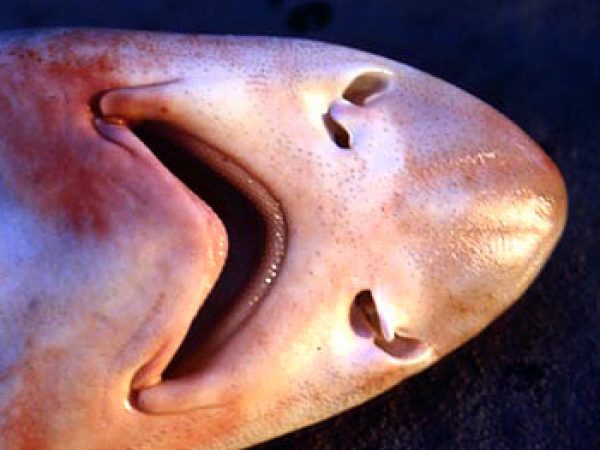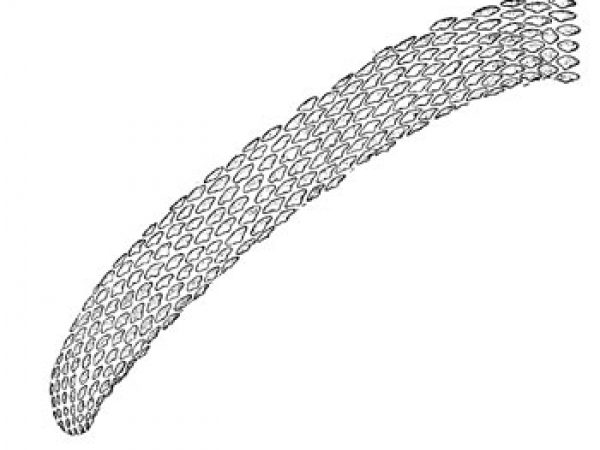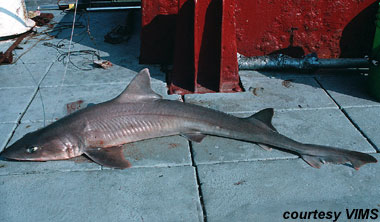
Mustelus canis
This small, slender shark has elongated cat-like eyes, triangular fins, and an asymmetrical, notched caudal (tail) fin. Unlike most sharks, this dogfish has rows of flat grinding teeth rather than sharp blades, which are ideal for crushing and chewing the crustaceans and mollusks that it hunts. It is a migratory fish that prefers the inshore waters of the western Atlantic, but because of its size, averaging 48 inches long, it is considered harmless to humans.
Order: Carcharhiniformes
Family: Triakidae
Genus: Mustelus
Species: canis
Common Name
- English: smooth dogfish, Atlantic smooth dogfish, dogfish, dusky smooth-hound, grayfish, nurse shark, smooth dog, smoothhound, smooth hound
- Spanish: boca blanca, boca dulce, caella, musola dentuda, viuda dientuda
- Portuguese: cação cachorro, sebastião
- French: chien de mer gris et roux, emissole douce
- Dutch: donkere toonhaai
- German: glatthai
- Japanese: inu-hoshizame
- Finnish: koirahai
Importance to Humans
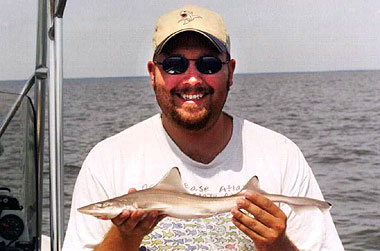
In recent years, there has been increased interest in the commercial fishery for smooth dogfish. Prior to the 1990s, annual landings of this dogfish were less than 80,000 pounds (36.29 tonnes). However, in 1995 landings exceeded 2.6 million pounds (1,200 tonnes) according to the National Marine Fisheries Service. The harvest stabilized in the early 2000s to annual landings of slightly over 1 million pounds (453 tonnes). This commercial fishery exists primarily along the mid-Atlantic coast, off the states of Massachusetts, New Jersey, Maryland, Virginia, and North Carolina.
In other locations throughout its range, the smooth dogfish is fished with bottom and floating longlines and trawls. In these areas, the flesh is marketed as fresh or dried salted for human consumption.
The smooth dogfish is often utilized as a lab animal and in public display aquaria.
Danger to Humans
The smooth dogfish poses no threat to humans due to its small size and small blunt, pavement-like teeth.
Conservation
This dogfish is a small target in the New England and Mid-Atlantic gillnet fisheries, however it is probably considered by-catch in most fisheries.
> Check the status of the smooth dogfish at the IUCN website.
The IUCN is a global union of states, governmental agencies, and non-governmental organizations in a partnership that assesses the conservation status of species.
Geographical Distribution
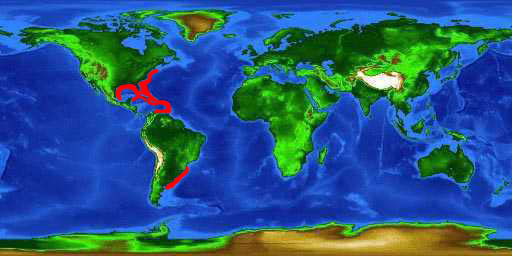
As one of the most abundant sharks on the east coast of the U.S., the smooth dogfish’s range is primarily the western Atlantic Ocean, from Massachusetts to Florida (U.S.), and from southern Brazil to northern Argentina. It is also found in the northern Gulf of Mexico, the Caribbean Sea, and Bermuda. M. canis insularis, considered a subspecies, has been documented in the Caribbean by Heemstra (1997). As mentioned above, populations of smooth dogfish are geographically isolated from each other. There appears to be little or no gene flow between these populations.
Habitat
A common resident on continental shelves, bays, and other inshore waters, the smooth dogfish prefers shallow waters of less than 60 feet (18 m) in depth but may be found to depths of 655 feet (200 m). This species has also been found on occasion in freshwater although it is unlikely they can survive freshwater for extended periods of time. The smooth dogfish migrates seasonally, moving north in the spring and south in the autumn. It is primarily a nocturnal species.
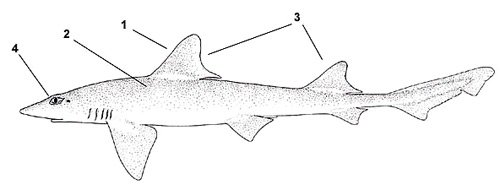
Distinguishing Characteristics
1. Fin spines lacking
2. No dorsal spots
3. First and second dorsal fins nearly equal in size
4. Eyes large, oval-shaped, and catlike
Biology
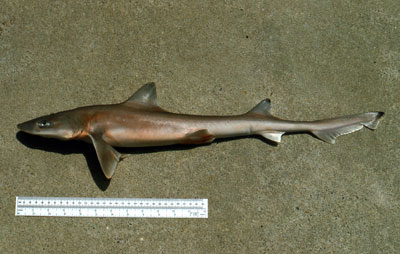
Distinctive Features
This small, slender shark has two large spineless dorsal fins with the first dorsal slightly larger than the second. The second dorsal fin is approximately twice as large as the anal fin and positioned slightly anterior to the anal fin. The lower lobe of the tail is rounded and much shorter than the upper lobe. The rear edge of the upper lobe has a deep notch near the tip. The smooth dogfish has a tapering, blunt snout and a spiracle behind each narrow eye.
The range of the smooth dogfish overlaps that of the spiny dogfish (Squalus acanthias), however it is easy to distinguish the two species. The spiny dogfish has one spine in front of each of the two dorsal fins while the smooth dogfish lacks dorsal spines.
The subspecies M. canis insularis appears identical to M. canis, however it differs in possessing a slightly higher dorsal fin and a longer caudal fin tip. The main distinction between these two species is the number of vertebrae, with the subspecies M. canis insularis having more vertebrae than M. canis.
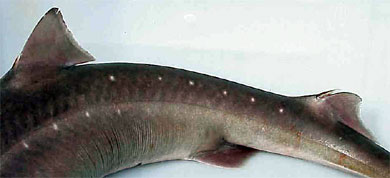
Although there are distinguishing characteristics between the two species, M. canis is also often confused with M. norrisi, the narrow smooth-hound. M. norrisi has a lower caudal lobe that terminates in a sharp point and is directed backward while M. canis has a rounded lower caudal lobe. The tips of both dorsal fins are also more pointed in M. norrisi.
Coloration
Coloration of the smooth dogfish varies from gray to brown with the underside a yellowish gray to white. It has the ability to change its coloration through the contraction of melanophores to camouflage with its immediate surroundings.
Newborn individuals possess a first dorsal fin that has dusky gray edges on the upper portion, the apex of the second dorsal fin also has dusky edges with a white rear edge and a tail fin edged in white below. These marking fade quickly, usually by the time the smooth dogfish has grown to two feet in length.
Dentition
Dentition of the smooth dogfish differs greatly from other sharks which have sharp blade-like teeth. The small teeth of the smooth dogfish are flat and blunt, similar in both the upper and lower jaws. They are asymmetrical with a rounded apex or cusp. Large mature smooth dogfish has tooth crowns that are low, hiding the cusps. The 8-10 rows of functional teeth are used to crush and grind prey items rather than bite and tear as with other species of sharks.
Denticles
Along the body of the smooth dogfish, denticles are irregularly spaced and lance-shaped with two to six longitudinal ridges extending the entire length of the denticle.
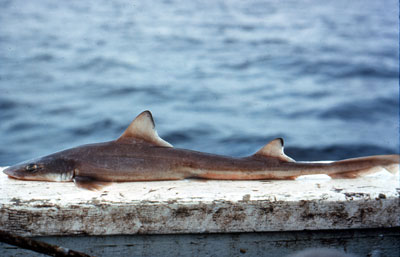
Size, Age, and Growth
Maximum total length for the smooth dogfish has been documented as 59 inches TL (150 cm) with a maximum weight of 27 pounds (12.2 kg). Smooth dogfish reach maximum size at seven to eight years of age. Average size of this shark is approximately 48 inches TL (122 cm). Longevity data indicates females live to 16 years of age and males have a life span of 10 years. This species grows quickly, with males reaching maturity at two to three years of age (27-37 inches TL (68-93 cm)) and females at four to five years of age (28-51 inches TL (70-130 cm)).
Food Habits
As a scavenger and opportunistic predator, the nocturnal smooth dogfish feeds primarily on large crustaceans, including lobsters, shrimp, and crabs, as well as small fish and mollusks. The flat, blunt teeth of the dogfish are used to crush and grind these prey items which have tough outer body coverings. Small fish that are preyed upon by the smooth dogfish include menhaden (Brevoortia tyrannus) and tautog (Tautoga onitis). Young smooth dogfish feed on small shrimps, polychaete worms, and crabs.
Reproduction
Mating occurs throughout most of the smooth dogfish’s range from May through July. Female smooth dogfish are capable to storing live sperm throughout the year, although it is unknown if this sperm can be utilized for fertilizing eggs. The smooth dogfish is a viviparous species with a yolk-sac placenta and a placental connection between the mother and embryo. Following a gestation period of approximately 10-11 months, a litter numbering as few as 4 and as many as 20 is born during late spring or early summer. Larger females tend to have larger litters of pups. Upon birth, the pups are 13-15 inches (34-39 cm) in length.
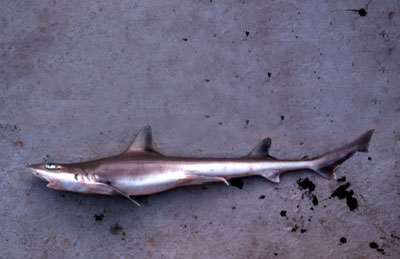
Predators
Sharks, including the dusky shark (Carcharhinus obscurus), blacktip shark (Carcharhinus limbatus), and great hammerhead (Sphyrna mokarran), are predators of the smooth dogfish.
Parasites
The nematodes Pseudoterranova sp., Anisakis sp., and Contracaecum sp. have been reported as parasites of the smooth dogfish.
Taxonomy
The smooth dogfish was originally described as Squalus canis by Mitchill in 1815 and later changed to the currently valid name of Mustelus canis (Mitchill 1815). Mustelus is Latin in origin, and is translated as “weasel-like” while canis means “dog” in Latin. Synonyms used in past scientific literature that also refer to the smooth dogfish include Allomycter dissutus Guitart 1972.
Mustelus canis insularis (Heemstra 1997) has been described as a subspecies of the smooth dogfish, occurring in parts of the Caribbean Sea. This subspecies usually occurs at greater depths (>655 feet (200 m)) than the M. canis and prefers rocky bottom habitats.
Species within the genus Mustelus are distinguished from other sharks by their slender bodies and flat, pavement-like dentition.
Prepared by: Cathleen Bester
